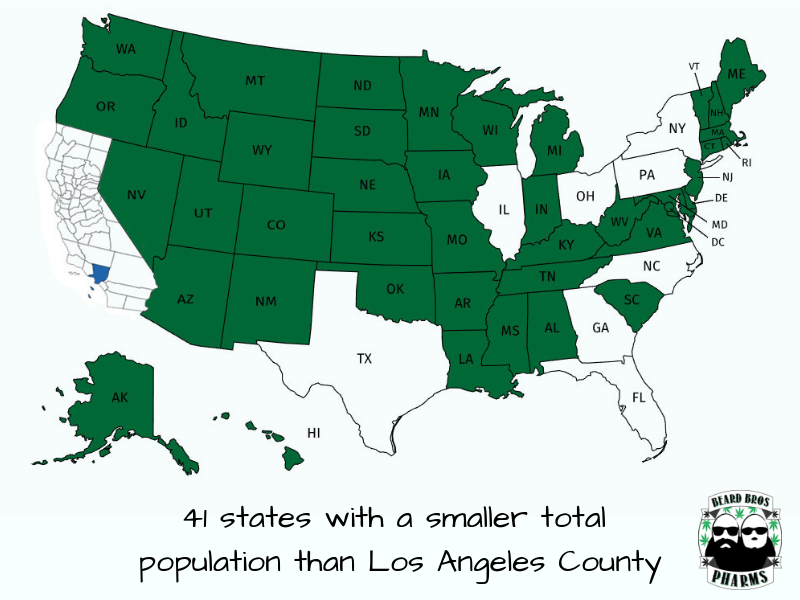
Last week in California, the Office of Administrative Law (OAL) approved the final regulations collectively written by the state’s three-headed beast of cannabis licensing agencies – the Bureau of Cannabis Control (BCC), the Department of Food & Agriculture (CDFA), and the Department of Public Health.
These final regs are effective immediately and seek to hit a hard reset on what has so far been a bit of a west coast clusterfuck by setting in ink the new laws that the agencies listed above have endorsed and that they believe will level the playing field for legal cannabis businesses.
In theory, we are to believe that it is Cali’s well-established and still thriving black market that is tripping up the state’s legal market. But the biggest stumbles have come from some of the ambitious attempts at instant and overbearing regulation that the state has tried to impose on a bunch of folks who’ve “been doing it since before you knew it could be done”, as our late friend and mentor Mickey Martin used to say.

Miss you, player…
From strict lab testing to the injection of accountability and liability into the industry, many of the regulations put forth by the state truly have the end consumer and their health in mind. However, Mickey also liked to often remind us that California is the 6th largest economy in the world, and so what may have worked in smaller emergent markets like Colorado, Oregon, or Washington, will be extremely more difficult in Cali.
The unfairly high costs of trying to enter the legal industry are just the beginning of the investment of time, energy, and money that it takes to survive in the current cannabis landscape in the Golden State.
A significant portion of these new production costs get attached to prices along the supply chain and along with a fat stack of separate taxes at the register, this leads to an undesirable and unsustainable price point for the end user, and that is why the black market, with its established round-number prices continues to rake in cash.
The state would have you believe that the black market feeds the legal market’s woes, but in reality it is the legal market’s burdens that are feeding the black market’s success – there is a difference.
Even putting prices aside. . . the lack of legal locations, the obnoxious overpackaging, and the ho-hum homogeneity of products on many dispensaries’ shelves are all further incentives for some stoners to just hit up the same homie that has hooked them up since high school.
What may be the best example of the double edged sword of cannabis legalization is the 2019 mandatory implementation of ‘seed-to-sale’ or ‘track and trace’ protocols to “record the movement of cannabis and cannabis products through the state’s supply chain”.
In an attempt to cut off any flow of black market weed into the legal market, or any legal weed from going out the back door and onto the streets, this cloud-based real-time tracking system will require the tagging and recording of growth, sale and transfer of cannabis product through the various tiers of the supply chain on its way to the retail cannabis consumer.
Unique RFID (Radio Frequency Identification) tags will be assigned to batches of clones. Once the plants grow larger, each will be tagged individually. These tags can be quickly scanned to input or update the operation’s digital database and that information is available in real time to state-lever observers.

That tag also indicates each plant’s strain, propagation method, cultivation location, intended use and the precise number of plants in nursery, vegetation, flower, harvest and sold stages. Third party lab tests can also be encoded onto the tags for easy reference.
All wholesale and retail sales will be recorded and all of that data will all be available to the state’s authoritative bodies. Let’s face it; at the end of the day they’re making sure that they get every penny that they’re due through their draconian taxation policies.
California has contracted the job out to a third party company called Franwell Inc. and their somewhat infamous track & trace software called METRC, or Marijuana Enforcement Tracking Reporting Compliance.
Their software will give the state an always-on Big Brother peek at certain licensed activity occurring in the market including inventory quantities, inventory transfers and sales, and other compliance issues. The benefit for licensees forced to use the software is said to be the peace of mind of having less liability if or when something goes wrong with the product once it is out of their hands.
Anyone applying for a cultivation or retail license through the CDFA must now take a mandatory California Cannabis Track and Trace (CCTT) training course in preparation for what will be a major change in standard operating procedures for many in the industry.
It will take time and money to train employees on the system and to keep it accurate and up to date. There will need to be a licensed “weighmaster” on site to make all weight measurements and recordings.
Just more costs that will trickle down to the checkout counter at the dispensary.
SO IT BEGINS
The rollout for seed-to-sale tracking in California will be slow for all, awkward for most, and painful for some.
Those who have been fully licensed by the CDFA and have met the training requirements will be mandated to use METRC, but many of their clients and supply chain contacts will still be operating on temp licenses, and so they will not yet have access to METRC, which will lead to a mixing of data formats that will need to be constantly reconciled and gives me a headache just thinking about it.
The cost of the program ranges from $250 – $20,000+ per month, depending on the size of the operation it is assigned to.
Mistakes are sure to be made on all ends of the system as the program is established, but what will happen if California ever becomes the Legal Marijuana Mecca that it is destined to be? How will METRC hold up to servicing the 1st largest cannabis economy on the planet?
In Colorado, where the adult recreational use of cannabis was legalized in 2014, badged cannabis industry workers have found ways to scam the METRC system.
By using the wiggle room given in categories for “Waste” or “Lost” product, a two-timing budtender or a maligned manager can claim that a few grams a day fell on the floor, or turned out to have mites, or some other excuse to “trash” perfectly good weed that they then sell on their own time in the untaxed, unregulated streets of Colorado.
These loopholes are potentially business-killers for an owner who likely has no idea that he’s getting pinched by an employee, and then potentially by investigators.
In Nevada, state regulators recently made the switch to METRC after a dangerously embarrassing stint with a service named Leaf Data, part of an outfit called MJ Freeway.
You may remember a couple years ago, in 2017, when MJ Freeway was hacked and its source code was posted publicly on Reddit. The company stated at the time that the security breach had no impact on the customers’ private information, though the state itself later got hacked and did lose such info on roughly 11,000 people.
Washington state is already on its second stab at a track and trace program and in Oregon, the seed to sale system says that they have a million unsold pounds of pot, roughly enough for 4 free ounces for each of the state’s 4 million residents.
Four million residents, eh?
3 mill or so in Nevada.
5.6 mill in Colorado.
7.4 mill in Washington.
Well, we’ve got 40 million in California so any problems that these smaller markets have experienced could be scaled up greatly once the experiment is fully underway here.
Hell, harking back to our dude Mickey one more time, there are more people in Los Angeles County alone (10.16 million) than there are in 42 states in this country. . . Cali is a different beast.

In theory, once an operation has the system up and running it’ll be routine daily maintenance not unlike the yawn-inducing, time-consuming accounting found in other industries. The program will help to prevent diversion of cannabis from California’s legal market to other non-legal states, it will fill local and state coffers with increased tax revenues, and it will aid in recalling or eliminating specific batches of defect product that is found to be unfit for consumption.
Hopefully the transition period to get to that point doesn’t do more harm than good. So far, the track and trace trial by the free market has produced mixed results, but the real test is about to begin.
==========
For those looking to navigate their way into California Cannabis Track and Trace, CDFA’s CalCannabis Cultivation Licensing Division is holding FREE workshops throughout January and into February.
“The workshops will provide a general overview of how the track-and-trace system works and how it will be used by all state cannabis licensees, including those with licenses for cannabis cultivation, manufacturing, retail, distribution, testing labs, and microbusinesses.”
Registration is not required; seating is first come, first served. Additionally, a recording of a workshop will be posted on the CalCannabis website by mid-February.
Two identical workshops will be held at each of the following locations from 9 a.m. to 12 p.m. and 1 p.m. to 4 p.m. The dates and locations include:
-
Monday, January 29—Kern County
Bakersfield Marriott at the Convention Center801 Truxtun Avenue, Bakersfield 93301
-
Wednesday, January 31—Los Angeles County
University of California, Los Angeles
Ackerman Union, Grand Ballroom
308 Westwood Plaza, Los Angeles 90024
-
Friday, February 2—San Diego County
San Diego Convention Center
111 West Harbor Drive, San Diego 92101
-
Tuesday, February 6—Riverside County
Moreno Valley Conference Center
14075 Frederick Street, Moreno Valley 92553
For more information, please see Frequently Asked Questions: California Cannabis Track-and-Trace System
Keep updated on all the latest news and updates in the Cannabis industry here at Beard Bros Pharms by signing for our Friday Sesh Newsletter here. Always Dank and Never Spam!

















